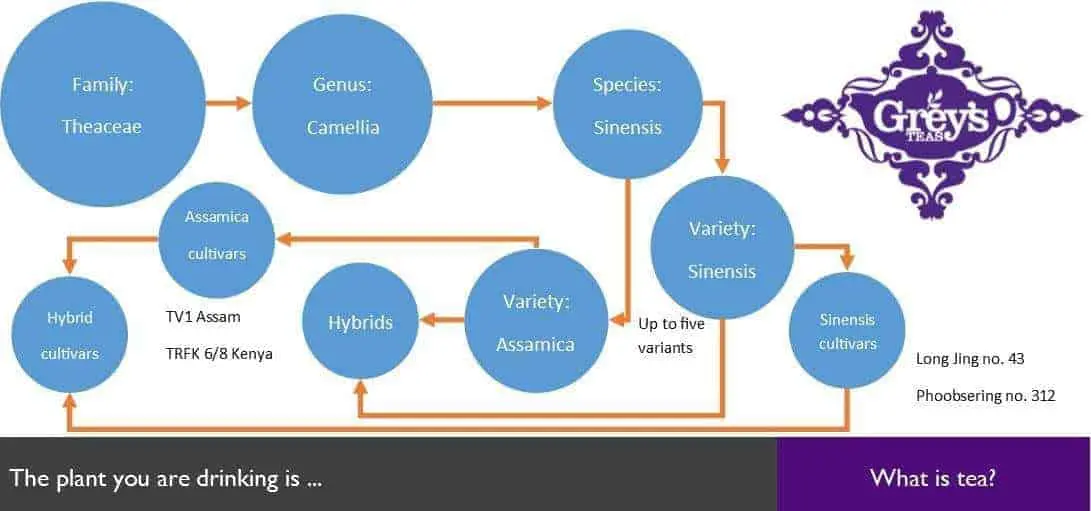Your basket is currently empty!
What is tea? An evergreen shrub thought to have originated wild in the Brahmaphtra valley of northern India and in Yunnan Province of western China.
So, what is tea? It is a member of the Camellia family, typically growing in well-drained, acidic upland soils where there is plenty of rainfall and humidity. Tea is native to Asia. Separate varieties, Camellia sinensis var. assamica – native to the west, has developed from Camellia sinensis var. sinensis, or Chinese Camellia, which is native to the east. The former has a larger, broader leaf than the narrower Chinese variety. These native tea areas are divided by the Patkai highlands of Burma.
Camellia sinensis grows in neutral to acidic soils commonly associated with upland areas having annual rainfall of over 40 inches. Temperatures tend to be tropical or subtropical with the effect that climates tend to be humid.

Camellia sinensis is a plant that has a life of around fifty years. It takes two and a half to five years to become fully mature. It is pruned every two to four years to keep its height down to a manageable three feet with a flat top for ease of picking. Left un-pruned, a bush would grow to become a tree of 30-40 feet in height. In this natural state it is used for seed production.
It is grown from as far north as the Russian republic of Georgia to as far south as Santos in Brazil. Cultivation requires warm, sub-tropical climates with high rainfall of over 50 inches per annum and it grows at altitudes up to 7,000 feet, on acidic soils. There are a number of hybrids created through natural selection between the two varieties. Tea planters have also created specific cultivars based upon pure assamica or sinensis varieties such as TV1 (Assam) or Long Jing No. 43 (China).
How is Camellia sinensis Produced?
It is picked during the ‘flush’ or growth phases of the bush. In India these growth periods occur during December and January, but it is all year round in Sri Lanka. April onwards is the best period for China teas.
For the best quality only the bud and top two youngest leaves are picked. A skilled picker will pick thirty to sixty pounds per day. A pound of manufactured tea may require as many as 3,000 shoots. Black tea will have been picked on a clear morning when the dew has just evaporated.
Once picked it is withered on mesh racks for between 8 and 24 hours to allow the moisture content of the leaf to reduce. Any stalks or impurities are removed by sieving. It must be manufactured near the gardens as it must be made from freshly plucked leaves but in some instances these may have been grown in several independently owned gardens in the vicinity. This can particularly be the case in certain Chinese provinces and in East Africa.
In the traditional orthodox method, the leaf is squeezed by rolling, releasing juices onto the surface of the leaf. It is this method by which virtually all our teas are made.
The leaves are laid out in a cool, humid atmosphere. For black tea the leaves are left from twenty minutes up to three hours to allow the polyphenols in the juices to oxidise – turning to a coppery colour. For more details about how green teas are made see our Green Tea page.
The leaf is dried, known as firing, in hot air from a furnace at a temperature of between 80 – 90 degrees F, for about thirty minutes, until about a third of the leaves’ moisture content has been lost.
It is fired, turning black teas to their characteristic colour. This can be done in pans, over a fire and, more commonly now, with hot air. Lapsang Souchongs are fired over a pinewood fire. We stock two excellent Lapsang Souchongs.
Grading
Graded by size. We focus on the large leaf grades for these give a more all-round and balanced cup. These grades do not apply to China.
- FTGFOP – Finest Tippy Golden Flowery Orange Pekoe
- TGFOP – Tippy Golden Flowery Orange Pekoe
- GFOP – Golden Flowery Orange Pekoe
- FOP – Flowery Orange Pekoe
- OP – Orange Pekoe
- BOP – Broken Orange Pekoe
- Fannings Small leaf grade. Use for teabags.
- Dust – The finest leaf particles. Used for cheap teabags.
The Chinese Ming dynasty (1368-1644) classified teas according to the colour of the infused liquor: white yellow, green, red and black. Today we use the classification above.
Our Tea Store
See our catalogue for Black tea.
Why we only sell loose leaf tea
Large leaf teas have a smaller surface area relative to weight. Therefore the easily soluble elements of the flavour such as tannins do not become too dominant in the liquor. This gives time for the more subtle and complex flavours to become infused. This does mean however that a good loose leaf tea takes longer to brew than teabags. Allow from three to five minutes, depending upon the type. Teabags require the smallest leaf grades to be used in their manufacture. Teabags therefore do not allow the full balance of flavours to be infused into the cup. Given too much time the tea they produce will be bitter, containing too much tannin.
Find out about Oolong Tea. This is a semi-fermented tea, between that of a black and a green tea. Oolong is otherwise known as Black Dragon.
Want to know more? See our blog posts on specific types of tea: What is black tea, what is oolong tea, what is yellow tea, what is white tea and what is English tea?
